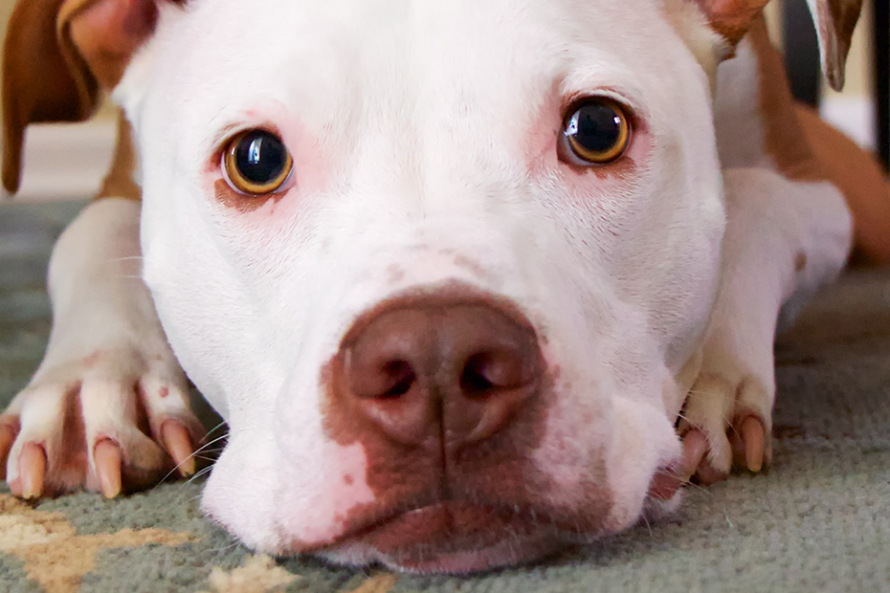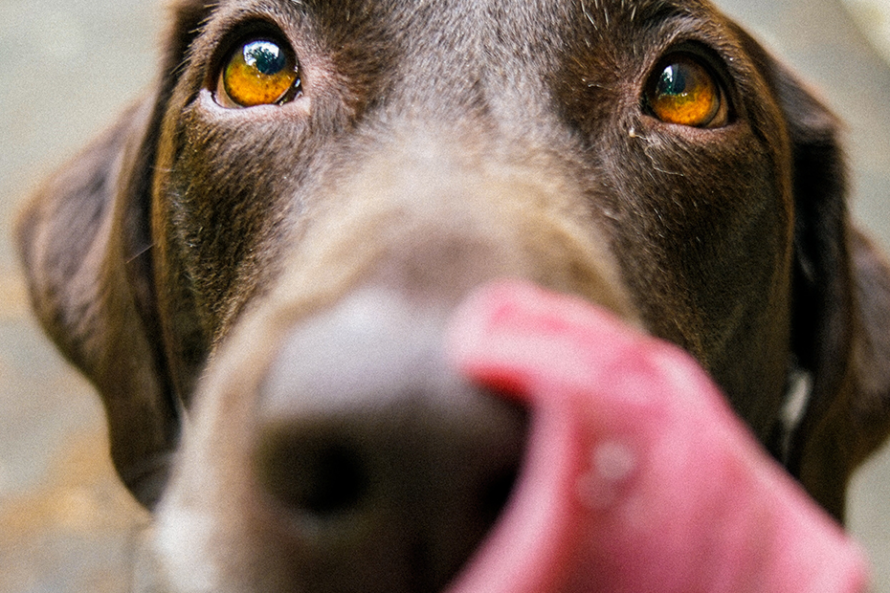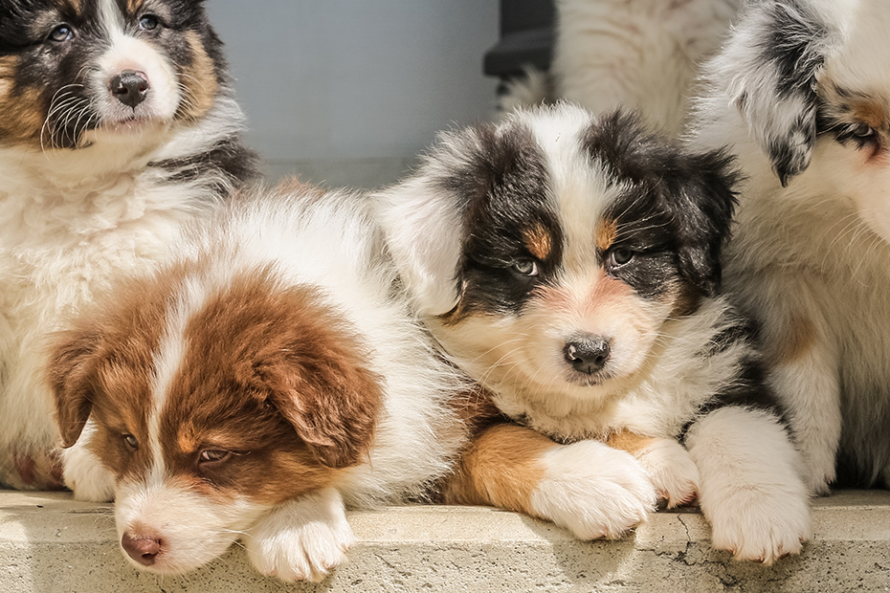1. WHAT IS PROTEIN?
Protein is a very important part of a healthy balanced diet and has several roles in the body such as hormone control, enzyme activity, immune function, tissue growth & repair, metabolism, brain chemicals & moods and heart function.
These are long chain molecules made up of 22 standard amino acids and are divided into two groups:
- Essential: the body must have it
- Non-essential: the body can manufacture it or doesn’t need it
The group of amino acids which are considered essential differs with species.
Amino acids essential for dogs are Arginine, Isoleucine, Lysine, Phenylalanine, Tryptophan, Histidine, Leucine, Methionine, Threonine and Valine.
Amino acids from food proteins are the building blocks of all proteins synthesized by the body to ensure its vital operation and psychological functions.
2. WHAT IS CONSIDERED A HIGH PROTEIN DIET?
There is no hard and fast number when it comes to classifying products as being high protein nutrition but there are a couple of points to consider.
Firstly, always compare diets by the guaranteed analysis, this is found on the back of the pack that tells you what levels are in the finished product. This analysis is the best way to compare foods’ protein content and avoid the confusing marketing claims on the front of the packs.
Most premium diets contain around 22-28% Crude Protein. As a high protein offering, this amount in the guaranteed analysis can increase between 30-37% Crude Protein.
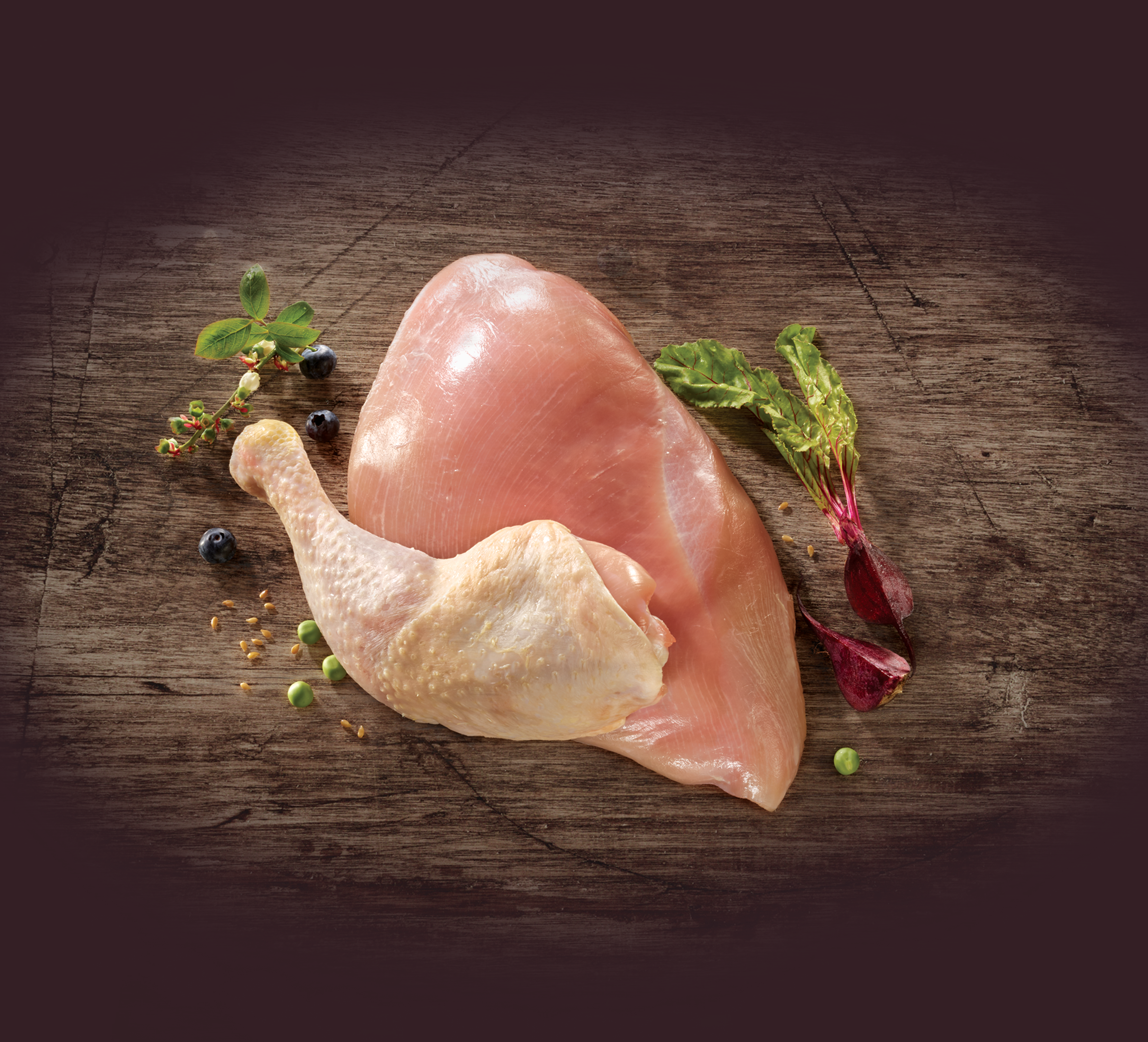
3. WHY FEEDING A HIGH PROTEIN DIET IS IMPORTANT AND HEALTHY FOR YOUR DOG
When high-quality meat-based proteins such as turkey, chicken or salmon are included at increased amounts into a dog’s diet, this can deliver nutrition that vitalises their well-being:
- As a key macro-nutrient, dietary protein is essential for the growth and for maintenance of almost all tissues in a dog’s body.
- Protein works to supply the amino acids necessary for the dog’s body to build hair, skin, muscles, cartilage, tendons, and ligaments
- Protein makes up the enzymes that drive all metabolic reactions, the hormones that act as the body’s chemical messengers and antibodies that comprise the immune system to help keep dogs healthy.
- Protein helps ensure a soft and shiny coat, lean, strong muscles, and strong immune systems
- Protein, especially animal-based, is highly palatable and helps your dog love every bite of their food to ensure bowls are always empty.
- The required amounts will vary for size, lifestyle and age of your dog.
When meat-rich proteins are included in higher amounts in dogs’ diets, a dog will not only look great but feel great too.
4. ARE THERE ANY DOGS THAT SHOULDN’T EAT A HIGH PROTEIN DOG FOOD?
One of the biggest myths in relation to higher protein diets is that they can be unsafe for large breed puppies, older dogs and overweight dogs. In all three cases these myths have been disproven by sound, robust and continual scientific studies.
Protein FACT #1: There is no direct link that protein contributes to musculoskeletal growth disorders in large breed dogs.
Studies have shown that differences in protein intake with levels of 15%, 23% and 32% protein did not affect the occurrence of skeletal development in Great Danes. The bigger culprits that directly correlate with orthopaedic problems in large breed puppies are excess calorie intake or increased calcium levels due to over-supplementation.
Protein FACT #2: Higher protein diets promote superior weight loss and body condition maintenance.
Obesity levels today are alarmingly high at 54% of dogs. Key contributors include the sedentary lifestyle of many dogs as well as the types and amount of food we’re feeding them.
Research has shown that dogs fed a higher protein diet with lower carbohydrates lost more weight. In these studies, dogs also maintained their lean muscle mass while losing fat, leading to overall improved body composition than dogs fed a high carbohydrate, low protein diet.
Protein FACT #3: Older dogs benefit high protein dog food with no risk to their kidney health.
Thanks to robust medical preventative care and disease treatment, dogs today are living longer than ever, reinforcing the importance of tailoring our nutrition to support the ageing dog. As a dog ages, they require more protein. When insufficient protein is provided, it can aggravate the age-associated loss of lean body mass and may contribute to lowered mobility and earlier mortality.
Feeding higher protein to an older dog helps support their increased requirements, maintains their muscle mass for mobility and most importantly, has been shown in numerous studies to have no adverse effects on a dog’s kidneys.
A protein-restricted diet is only recommended for dogs that have been diagnosed with chronic kidney failure. Restricting protein for healthy older dogs is not only unnecessary but could be detrimental.
5. IS THERE A LINK BETWEEN HIGH PROTEIN DIETS AND BEHAVIOURAL ISSUES?
One of the most common myths is that high protein dog foods can cause hyperactivity and or aggression in dogs.
Dogs are omnivores and have evolved to eat diets rich in protein. The relatives of dogs, wolves, eat a prey-based diet which is normally high in protein and low in carbohydrates.
Interestingly, a wolf’s diet is typically made up of 52% protein, 47% fat and 1% carbohydrates.
Furthermore, the milk provided by a lactating bitch is predominantly higher in protein compared to other species such as humans and cows. This reflects both a high dietary protein requirement as well as a metabolic adaptation to manage it.
A study undertaken by Dodman* on the effect of dietary protein on behaviour in dogs showed that the aggressive behaviour in dogs was unchanged by changes to dietary protein levels. Further studies were undertaken in 2000 looking into whether high protein diets could cause hyperactivity or aggression in dogs and the conclusion was made that a connection could not be found be proven.
As there are no peer reviewed publications that detail any adverse effects associated with high level protein intake, there are no regulatory bodies that set a maximum level for any life stage.
6. CAN HIGH PROTEIN DIETS CAUSE ITCHY SKIN?
Another common misconception is that high protein diets can cause itchy skin. Good quality protein fuels skin & coat health. Hair is 90% Keratin requiring large amounts of daily dietary protein.
The quality of protein is determined by the amino acid composition of the protein, its digestibility, and its ability to meet an animal’s requirements.
Sometimes dogs will have a sensitivity, allergy, or intolerance to certain types of proteins, such as pork but this is more to do with the protein source and not the quantity.
Also certain grains may be linked to sensitivities, that’s why we exclude them.
Wellness CORE recipes provide highly digestible, high-quality protein sources.
We also have a variety of recipes that have different protein sources or are single-source protein so if there is one you want to avoid, we have other options.
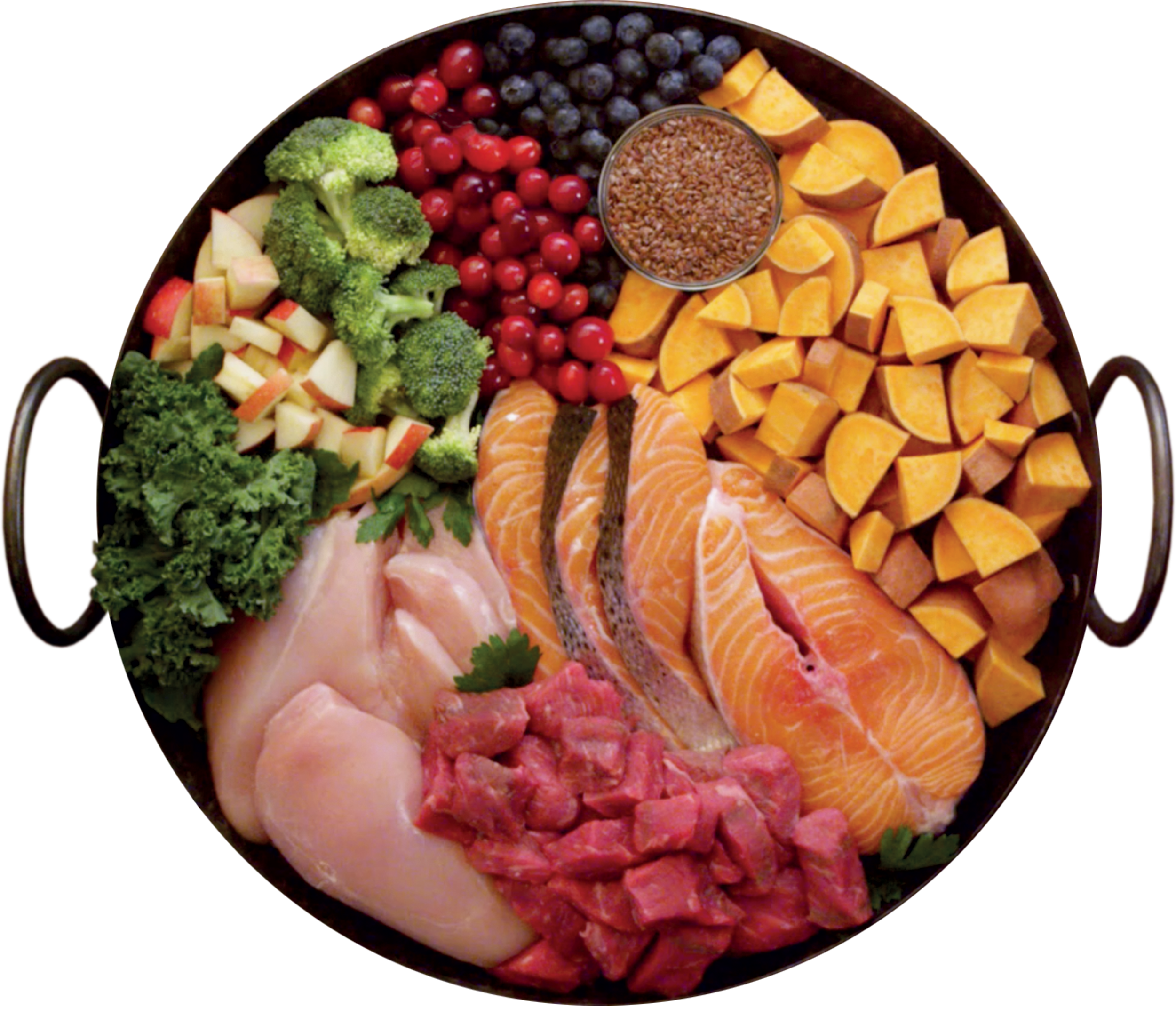
7. THE RISKS OF NOT FEEDING ENOUGH PROTEIN
The most common signs of protein deficiency are;
- Reduced growth rate
- Reduced milk production
- Poor coat and skin
- Weight loss
- Anaemia
- Change of mood
Protein deficiency can have an adverse effect on all of your dog’s organs, immune system and cells. It can also affect the intestine and can lead to leaky gut syndrome. Some deficiencies can even cause liver disease, depression, lameness and neurological issues.
Here at Wellness CORE, we believe that when it comes to feeding your dog, protein is one of the most important ingredients you need to look for when selecting the best food for your dog.
8. SELECTING A HIGH PROTEIN DOG FOOD
Feeding a diet rich in meat protein helps promote the optimal health of all dogs from Chihuahuas to Great Danes. When high meat is combined with a moderate fat level and a lowered amount of grain-free carbohydrates, the result is perfectly balanced nutrition ensuring a dog can thrive in all life stages from an active puppy to a sedentary senior.
Now, this approach is different to some high protein diets that claim to feed your dog like a Wolf. Whilst these diets are high in protein, they may also be combined with high fat levels. These high fat levels were crucial for wolves to fuel their highly active lifestyle as well as ensure they survived the harsh times of famine. Today though, our dogs not only look very different from a wolf, but they are far less active and genetically have different dietary requirements. So, whilst protein remains a very important dog food ingredient, we need to make sure the fat levels are not too high.

Wellness CORE delivers natural, superior protein-rich, nutrition that’s specifically crafted for modern dogs to thrive. Featuring fresh meat and concentrated meat sources as our key ingredients, every Wellness CORE recipe is combined with moderate amounts of fat, low carbohydrates and a unique blend of wholesome fruits, vegetables, superfoods, botanicals and nutritional supplements to be the best meat-based nutrition available.
Furthermore, in all our Wellness CORE products we include the amino acid Taurine. This is essential for cats but not dogs however, it plays a key role in most organs and helps with brain health, heart health and eye health.
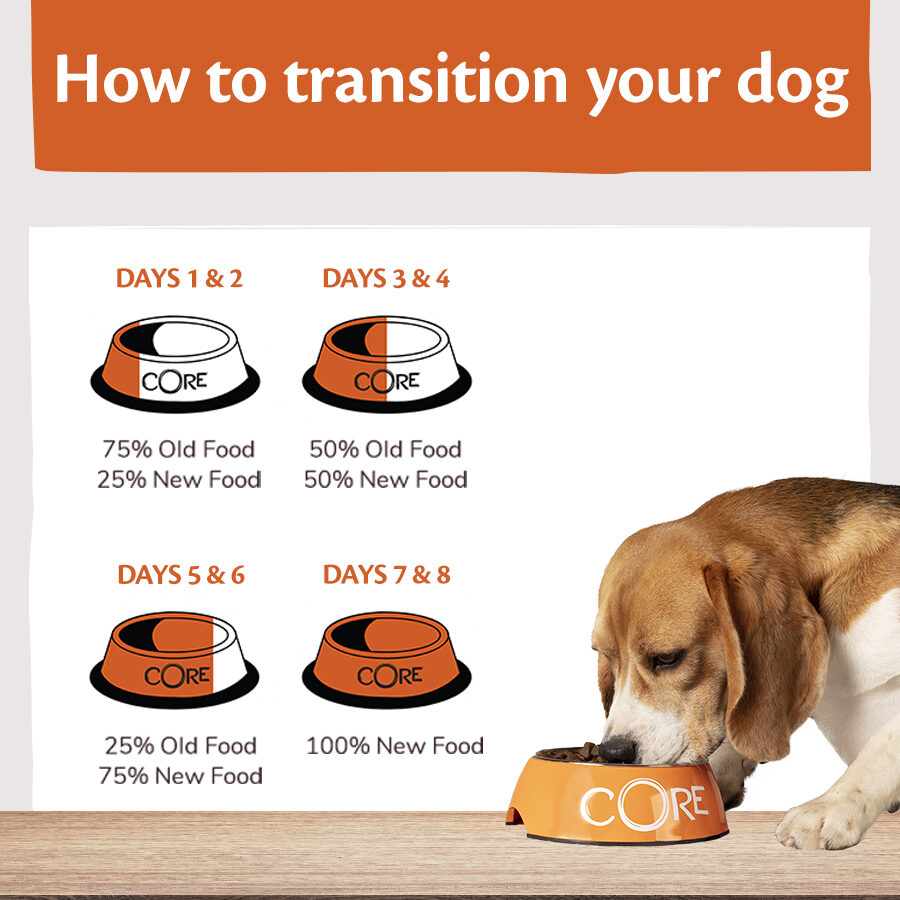
9. HOW TO TRANSITION YOUR DOG ONTO WELLNESS CORE
New pet food should be gradually introduced to your animal by mixing it with their current food. For a nice, slow transition, replace the old food with the new food in small increments over the course of one week. It can take 4 to 6 weeks for a pet’s digestive tract to fully adjust to a new diet so do not be alarmed if your dog’s transition takes a little longer.

